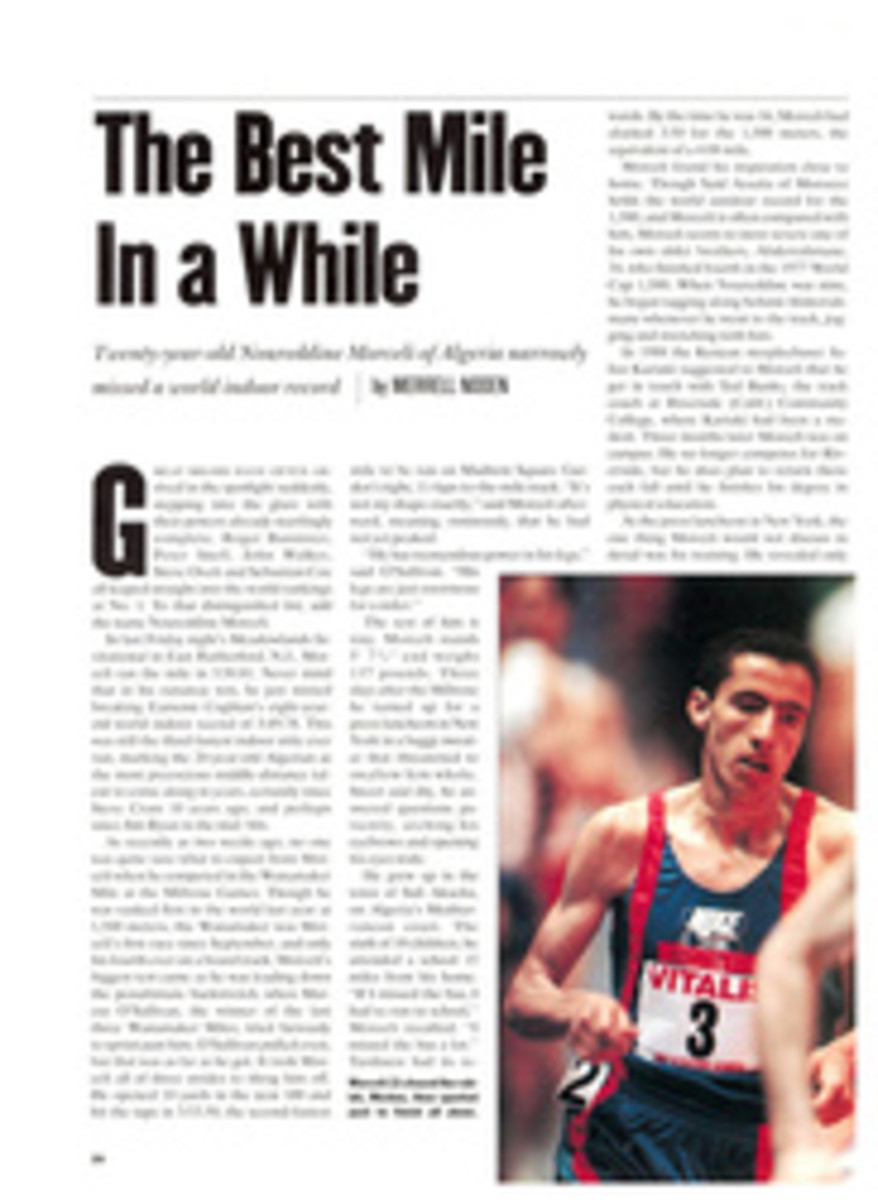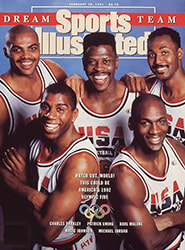
HIGH SCHOOL BASKETBALL
Eyes on the Prize
Let's face it, Sunday's UNLV-Arkansas showdown (page 16) overshadowed the rest of the college basketball scene, so this week we're taking a break from the colleges to look at high school basketball. Most of the names won't be familiar, but you'll be watching and reading a great deal about some of these players over the next few years.
One name to remember is Chris Webber, a 6'9" senior forward at Detroit Country Day School. He's involved in the hottest recruiting battle in the country, between Michigan and Michigan State. Many talent scouts think Chris is the best schoolboy player the state has produced since Magic Johnson.
Although Chris hasn't eliminated Duke and Minnesota from consideration, it would be a major surprise if he didn't join the Spartans or the Wolverines. One school of thought has it that Chris will sign with Michigan, because 1) at one time he wanted to play at Detroit Southwestern High for coach Perry Watson, but his parents steered him to Country Day because of its better academic reputation, and 2) Watson is one of the leading candidates to fill an assistant-coaching position at Michigan. A spot has been vacant on Wolverine coach Steve Fisher's staff since Mike Boyd, Fisher's chief recruiter, left last September to become the coach at Cleveland State. What's more, Michigan is also interested in two of Watson's players, 6'7" forward Jalen Rose and 6'4" guard Voshon Lenard.
Watson has several qualities that would recommend him to the Wolverines. He has been highly successful at Southwestern, where he has a career record of 291-34 in 13 seasons. Watson also knows the Detroit high school scene inside out. Still, if Watson ends up in Ann Arbor, along with Chris, Jalen and Voshon—or two of the three—it's not hard to imagine the questions that will be asked.
Summertime Blues
Sometime next month, the last state title will be decided, and the high school season will officially be over. However, hundreds of players around the country will have little time to relax. The proliferation of spring leagues, summer leagues, all-star camps and traveling AAU teams have made basketball a year-round pursuit for many youngsters, especially those trying to earn a college scholarship.
It's not unusual for a topflight high school player to compete for his school from November to March, then play on the off-season circuit until it's time for high school practice to begin again. In many cases, a kid has almost no time between the end of one season and the beginning of another. Last March, Martin Luther King High in Chicago completed a 32-0 season by winning the Illinois state championship game on a Saturday night. King's opening game in a local spring league was scheduled for two nights later.
The irony is that the early signing period—during November of a player's senior year—which was instituted in the mid-'80s to ease recruiting pressure, has instead added to it. College coaches now do much of their recruiting during the summer, and the competition for scholarships is often decided by how a player performs in the camps and summer leagues. "The more leagues and tournaments the kids compete in, the better their chances of catching some recruiter's eye," says Wayne Merino, coach at Artesia High in Lakewood, Calif.
The never-ending season is troubling for another reason. Because the summer leagues aren't under the jurisdiction of the high school associations or the NCAA, players commonly receive sneakers, T-shirts, jackets and other incentives. Is it any wonder that many players learn to expect some form of payment for their college services?
Proponents of the off-season leagues argue that players would be on the courts year-round even without organized leagues. That's true, but many of these leagues are plagued by a meat-market atmosphere, which makes it hard to believe that once upon a time, players got together on their own in the summer and played pickup games. For fun.
Robbing the Cradle
Jason Kidd and Konecka Drakeford are household names—at least in the households of college recruiters. Jason, a 17-year-old, 6'4" junior, and Konecka, a 15-year-old, 5'10" sophomore, are among the best male and female high school players in the country, respectively. Not surprisingly, they are also good examples of how early players can become the focus of recruiting battles.
Jason, a guard at St. Joseph Notre Dame High in Alameda, Calif., is considered the nation's premier schoolboy junior. He received his first recruiting letters shortly after completing the eighth grade, at age 14. "I hadn't even taken my first high school class yet," says Jason. "I was flattered, but I was thinking, Already?"
Konecka, a forward at Providence Day School in Charlotte, N.C., was even younger when the competition for her attention began. As a 12-year-old she was named MVP of the 13-and-under division at the 1988 AAU Junior Olympics in Shreveport, La. The letters started arriving almost immediately.
It's easy to see why both players are considered such prizes. Jason is an exceptional ball handler and passer who at week's end was also averaging 25.5 points, 10.4 rebounds, 8.9 assists and 5.1 steals for the 20-3 Pilots. Konecka was averaging 42.3 points a game for the 20-4 Chargers, despite being triple-teamed regularly.
Recruiters aren't the only ones trying to get close to Jason, who has narrowed his list of college possibilities to 14. He has gained the kind of fame on the high school scene that's usually reserved for rock stars. "Little kids mob Jason for autographs before and after games," says his coach, Frank LaPorte. "And he gets letters from people of all ages all over the country: 'Jason, I just want to tell you how much I admire you.' 'Jason, will you send me an autographed picture?' Girls have T-shirts with pictures of him."
Konecka hasn't yet begun to reduce her list of schools. She estimates that she has heard from more than 300. "The intensity of recruiting in the women's game is just about equal to that of the men's game," says Providence Day girls' coach Barbara Nelson. "The bottom line is that if you're a talented player, boy or girl, you're probably going to be approached by colleges before you get to high school."
Last Chance High
Glen Mills School, the defending Pennsylvania Class AAAA champion, brings in players from all over yet will never be accused of recruiting. That's because the Bulls players, like all of the all-male student body of 710, were sent to Glen Mills by the juvenile courts.
"Many of the kids here ran into trouble with the law for gang-related offenses—burglary, vandalism, things like that," says Bulls coach Tom Mann. "The courts send them to schools like ours as a chance to get an education and maybe begin to straighten their lives out. In effect it's a last alternative before jail."
Several of Mann's players have taken advantage of that chance, including James Spears, who's now a freshman forward at Temple, and DuWayne Cheatum, a senior center for Coastal Carolina.
The students take great pride in the team. The school bussed the entire student body to a recent game with nearby Philadelphia Roman Catholic at St. Joseph's field house. (Roman Catholic dealt the Bulls their only loss of the season.)
Some rival coaches have complained that Glen Mills has an unfair advantage because it draws players from other states. On the other hand, Mann rarely gets to keep a player for longer than the time the court requires the player to attend the school, usually 15 to 18 months.
"I've been here 14 years and I've never had a player for four seasons," says Mann. "A kid can choose to stay longer than the court-appointed time, but most don't. But a lot of them learn something about hard work and accomplishment and pride and class before they leave."
Tip-ins
Charlotte (N.C.) Latin School (24-2) has one of the tallest front lines in the nation, taller than that of the NBA's Charlotte Hornets. Center Chase Metheney, a ninth-grader, is 7'1", Geoff Richards is 6'7" and Torsten Balkenhol, an exchange student from Germany, is 6'7".... Western High of Las Vegas seems to be a clone of UNLV. Through Sunday, the 24-2 Warriors were averaging 104.7 points.... Senior guard Kareem Townes of South Philadelphia High is the first player to average more than 40 points in the Public League since Wilt Chamberlain produced 47.2 in 1954-55. Kareem averaged 41.2 points this season.
[originallink:10671391:710891]
PHOTO
DAMIAN STROHMEYER
Is Michigan going to extraordinary lengths to make sure that Chris lands in Ann Arbor?
PHOTO
ANDY FREEBERG
Although only a junior, Jason gets loads of fan mail—most of it from college coaches.

